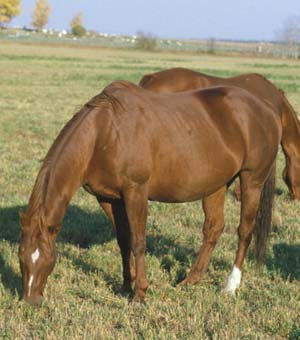Grazing systems used in horse farms include pastures, fences and management techniques used to provide optimal forage for horses. Grazing systems should be flexible based on resources and goals and developed to meet the horses nutrient requirements. Two common types of grazing systems used in horse farms are continuous and rotational.
Continuous grazing
A continuous grazing system is one where horses are houses on a single pasture for an extended period of time. Advantage to this system is that reduced fencing cost and less daily management is required. A disadvantage to this system is that it is difficult to manage grazing intensity and timing. Continuous grazing systems should be designed to enhance forage utilization by using good pasture management practices and setting appropriate stocking rates. If pastures are not managed properly forage availability is reduced. This type of grazing system is appropriate to use where ample pasture land is available to support the number of horses. Overgrazing should be avoided and plant species selected that will support continuous grazing. Increased management may be needed during periods of rapid or diminished forage growth.
Rotational grazing
Rotational grazing involves moving horses between pastures during the grazing season to allow for periods of pasture rest and regrowth. Time on each pasture will depend upon number of horses and pastures. Advantages to this system include ability to manage more animals on less acreage and improve forage availability and quality. The disadvantages are greater cost due to increased fencing and management.
Rotational grazing is a practice that, if done correctly, can help increase your pasture productivity. Rotational grazing is dividing the pasture area into several small paddocks.
Rotationally grazing your pasture should also allow appropriate rest periods. In fact, the key to pasture productivity with any rotational grazing design is providing adequate rest periods for pasture recovery and being flexible depending on the season. Resting the pasture is essential and allows the forages to store carbohydrates (energy) in their roots and regrow vigorously. Generally speaking, a pasture will need 30 days of rest for every 7 days of grazing.
Rotational grazing does not need to be complicated, as two pasture can be enough to practice rotational grazing. In some cases horses may need to be rotated before the pasture has been adequately grazed. In this case, horse owners may hay the paddock, or mow the forage to a height of approximately 4”. However, in a dryland arid system you should only graze off half of the growth (the take half keep half principal).
Rotational grazing also contributes to better manure management. Instead of one or two big dropping areas, there are several smaller ones throughout the pasture. Smaller manure piles dry and break up faster, reducing fly numbers and odor. Dragging the paddock helps break up the piles, dries out the manure, and distributes nutrients back to the pasture. Dragging should be done when horses are rotated out of the paddock.
Table 1 provides an example of rotational grazing in a midwestern, cool season grass pasture system.
|
Number of paddocks |
Spring |
Summer |
Fall |
|||
| Days of grazing /paddock | Days rested per paddock | Days of grazing per paddock | Days rested per paddock | Days grazing per paddock | Days rested per paddock | |
|
2 |
14 |
14 |
42 |
42 |
28 |
28 |
|
3 |
7 |
14 |
21 |
42 |
14 |
28 |
|
4 |
5 |
15 |
14 |
42 |
10 |
30 |
|
5 |
4 |
16 |
11 |
44 |
7 |
28 |
Table 1. Rotational grazing paddock designs (at recommended stocking rates) for horses based on 2, 3, 4, or 5 paddocks in the Northern U.S.
Interested in learning more about horses? Check out the Horses Learning Lessons.



